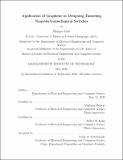| dc.contributor.advisor | Vladimir Bulović and Jeffery H. Lang. | en_US |
| dc.contributor.author | Gao, Mingye. | en_US |
| dc.contributor.other | Massachusetts Institute of Technology. Department of Electrical Engineering and Computer Science. | en_US |
| dc.date.accessioned | 2020-09-15T21:53:12Z | |
| dc.date.available | 2020-09-15T21:53:12Z | |
| dc.date.copyright | 2020 | en_US |
| dc.date.issued | 2020 | en_US |
| dc.identifier.uri | https://hdl.handle.net/1721.1/127343 | |
| dc.description | Thesis: S.M., Massachusetts Institute of Technology, Department of Electrical Engineering and Computer Science, May, 2020 | en_US |
| dc.description | Cataloged from the official PDF of thesis. | en_US |
| dc.description | Includes bibliographical references (pages 95-98). | en_US |
| dc.description.abstract | Nanoelectromechanical (NEM) switches are considered to be a promising substitute for conventional switching because they can provide a large on/off current ratio as well as near-zero current leakage during off-state. However, the stiction problem, which is caused by the significant effect of van der Waals force to the nanoscale structure, can easily lead to the permanent failure of the conventional NEM switches, thus lowering their reliability; such an issue also prevents the further miniaturization of NEM switches, thus leading to the high actuation voltage of them. The non-scalable fabrication flow of NEM switches also restricts their applications and popularization in industry. To realize the ultra-low power consumption while solving the typical problems encountered by the conventional NEM switches, a novel NEM switch called squitch is proposed in this thesis. | en_US |
| dc.description.abstract | The functionality of the squitch is based on the electron tunneling; specifically, the current through such a device can be modulated by controlling the thickness of a compressible molecule film, which serves as the tunneling barrier between an movable and a pair of fixed electrodes. Graphene is chosen as the material of the top electrode because it can be easily patterned and transferred; besides, partially getting rid of the metallic materials can help us determine if the electromigration will affect the device performance. Through modulating a 5nm-thick PEG-thiol monolayer, a on/off current ratio ranging from 10¹ to 10² can be achieved; a ~1 V actuation voltage and a sub-1 V hysteresis are also realized. The device can also survive 10 to 100 cycles of operations, showing an acceptable durability. Besides, we prove that the electromigration is not the major factor that causes the degradation behavior of the squitch. | en_US |
| dc.description.abstract | The yield of the whole fabrication process falls in the range of 20% to 40%, which can further improved by modifying the methods of transferring graphene and exploring new molecules with the appropriate mechanical properties. | en_US |
| dc.description.statementofresponsibility | by Mingye Gao. | en_US |
| dc.format.extent | 98 pages | en_US |
| dc.language.iso | eng | en_US |
| dc.publisher | Massachusetts Institute of Technology | en_US |
| dc.rights | MIT theses may be protected by copyright. Please reuse MIT thesis content according to the MIT Libraries Permissions Policy, which is available through the URL provided. | en_US |
| dc.rights.uri | http://dspace.mit.edu/handle/1721.1/7582 | en_US |
| dc.subject | Electrical Engineering and Computer Science. | en_US |
| dc.title | Application of graphene in designing tunneling nanoelectromechanical switches | en_US |
| dc.type | Thesis | en_US |
| dc.description.degree | S.M. | en_US |
| dc.contributor.department | Massachusetts Institute of Technology. Department of Electrical Engineering and Computer Science | en_US |
| dc.identifier.oclc | 1192475780 | en_US |
| dc.description.collection | S.M. Massachusetts Institute of Technology, Department of Electrical Engineering and Computer Science | en_US |
| dspace.imported | 2020-09-15T21:53:11Z | en_US |
| mit.thesis.degree | Master | en_US |
| mit.thesis.department | EECS | en_US |
